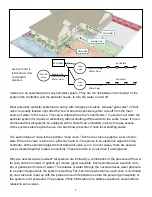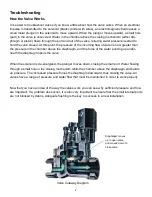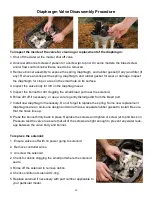
8
Troubleshooting
How the Valve Works
It is easier to troubleshoot valves if you know a little about how the valve works. When an electrical
impulse is transmitted to the solenoid (black cylinder with wires), an electromagnetic field causes a
small metal plunger in the solenoid to move upward. When the plunger moves upward, a small hole
(port) in the valve is uncovered. Water in the chamber above the closing mechanism (either dia-
phragm or piston) flows through the port and out of the valve, relieving water pressure needed to
hold the valve closed. At this point, the pressure of the incoming flow of water is now greater than
the pressure in the chamber above the diaphragm, and the force of the water pushing up under-
neath the diaphragm opens the valve.
When the solenoid is de-energized, the plunger moves down, closing the small port. Water flowing
through a small hole in the closing mechanism refills the chamber above the diaphragm and builds
up pressure. The increased pressure forces the diaphragm downward, thus closing the valve. All
valves have a range of pressure and water flow that must be maintained in order to work properly.
Now that you have an idea of the way the valves work you can see why sufficient pressure and flow
are important. If a problem does occur, it is also very important to ensure that the small internal ports
are not blocked by debris. Adequate flushing is the key to success in a new installation.
Valve Cutaway Diagram
Diaphragm moves
up to open valve,
and moves down to
close valve.
































